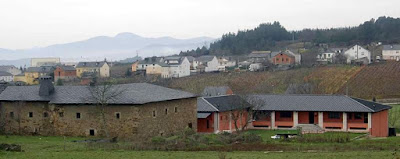 |
Château Sainte-Anne
from maisondesvins-bandol.com |
As I mentioned in the post above, the ‘natural’ quirky Sainte-Anne style has been with us for a while: this 15 ha (37 acre) estate, lying on the northeastern side of the Bandol appellation in Sainte-Anne d’Evenos, has been farmed organically(+) for twenty years by larger than life owners Françoise and Jean-Baptiste Dutheil de la Rochere. ‘Natural’ in the sense of not much used, done or added in the vineyard and cellar - “very few treatments in the field…” and “no SO2, fining nor filtration (for red winemaking),” for example - apart from working the vines and soil, picking the grapes, fermenting them and watching over their ageing in barrels. Bit of a simplistic cliché maybe but they like to keep it nice and simple. I went to the property and interviewed Françoise back in 2004 and tasted quite a few blends and vintages of their red wines, and my memory was something like a rollercoaster road of discovery. Certain wines were very traditional and pretty awesome in that way, while one or two others were teetering on the brink or probably a little more rustic than you might like. Jean-Baptiste agreed, when I tried their latest vintages at Millésime Bio wine show in Montpellier (Languedoc) last week, that “our wines have always been a bit on the wild side.” Right on, man.
Here are my condensed notes from that aforementioned late autumn 2004 trip just to weave in a touch of background and detail, extracted from a load of other material for a paper (yawn) I was doing on Mourvèdre back in 2005/06, although I don’t imagine much has changed essentially at Ste-Anne.
Françoise told me she believes “the microclimate here comes from the usually cool nights we get from the end of August, meaning we are among the latest to pick Mourvèdre (coupled with a lower risk of rot, so they can chance it more).” Her Bandol vineyards are on the higher ground facing southwest, and the lower-lying areas are classified as Côtes de Provence. A protective circle is formed by a range of hills all the way round to Le Beausset and the terraces behind the vineyard. Sainte Anne has clay/limestone soils with veins of sand underneath meaning it’s better drained, a “less heavy soil favourable to elegant reds,” as she put it. Their organic/biodynamic methodology takes in growing wild mustard grass between the vine rows and only using fertilisers from organic matter (shite). This is a “very old family property going back five generations, so there’s plenty of old vine stock,” although escat (a disease attacking and causing the wood to die) is a problem here limiting their age. They don’t use trellising since “it’s not easy to do and Mourvèdre stands up well in gobelets (bush vines) anyway!” And something mystical too about “creating magnetism…” or whatever I scribbled down followed by a double question mark??
On picking Mourvèdre at the right moment: “When it’s perfectly ripe and you squeeze the grapes, it leaves finger marks because of its thick skins,” Françoise explained. Fruit for their Cuvée Collection is usually left a day or so longer, in specific plots, for extra ripeness. “No SO2 is used for white and rosé before fermentation and usually none at all for reds.” Typical winemaking ‘techniques’, as exemplified by the very good 2001 vintage, include a relatively short period in vat of 12-13 days with one remontage (pump-over) per day. “It needs a good aeration each day but no more than that, otherwise the must becomes too extracted.” The reds are matured for about 18 months in old 50 hl foudres (very large tuns) - in fact they don’t use any new wood at all - “just for slow oxidation.” Blending is done after cask-ageing “because of Mourvèdre’s richness, I leave it pure (until then).” The S-A basic cuvée is made up of 60% Mourvèdre, 20% Grenache and 20% Cinsault. But her Cuvée Collection is typically 95-98% Mourvèdre selected by parcel (and slightly later picked) and isn’t made every year: 2003 and 2004 were looking likely at that time, none in 2002 as it was “too dilute,” 2001 and 2000 were both very good and 1999 was “unspectacular but well balanced.”
Click here to view my notes and reviews of those older vintages (goes to my mega-Bandol page in the "wine words" archive: scroll down quite a lot towards the bottom). There are more Ste-Anne wines here (Millésime Bio 2006) too. And now, over to those ‘latest’ vintages tasted last week:
2010 Bandol white (Ugni Blanc, Clairette Verte) - oily honeyed nose and palate, quite full then becomes more mineral and elegant with crisp bite. Good. About €15.
2010 Bandol rosé (Mourvèdre, Grenache, Cinsault) - quite developed with ripe raspberry fruit and rounded mouth-feel, lacks a bit of bite. Expensive too at €14.
2008 Bandol red (60% Mourvèdre) - nice ‘sweet’ black cherry with savoury black olive undertones, a hint of spice too with attractive tannins and subtle depth of fruit; 'lighter' more elegant style. €19
2005 Bandol red - developing savoury notes, richer chunkier firmer wine vs appealing maturing leather characters.
2006 Bandol Collection - more of that dark cherry fruit vs a wilder ‘animal’ side, solid gripping yet still rounded palate, it’s balanced and complex with it.



















